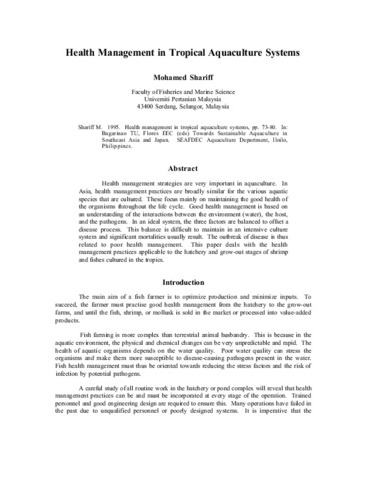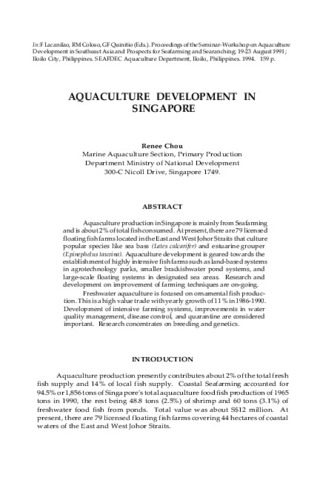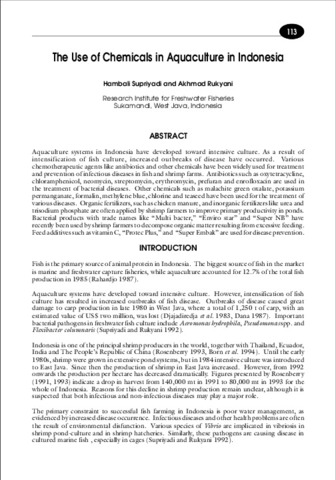Potentials of Kappaphycus striatum (Schnitz) and Gracilaria heteroclada Zhang (Ad Xia) to control the growth of luminous bacteria Vibrio harveyi

ရှာဖွေ/ဖွင့်ပါ။
ရက်စွဲ
2010Page views
584
Share
စိတ္တဇ
Different aquaculture species such as finfishes and bivalves have been reported to control the luminous bacterial disease of shrimp, usually caused by Vibrio harveyi. The use of seaweeds in shrimp culture system has reportedly improved water quality and reduced the bacterial count. This study evaluated the potentials of two species of seaweeds, Gracilaria heteroclada (Ad Xia) and Kappaphycus striatum (Schnitz), to control the growth of V. harveyi.
V. harveyi was inoculated into control tanks containing shrimps only and into treated tanks containing both shrimp and macroalgae. Luminous bacterial counts were monitored daily. From day 2 to day 6, luminous bacterial count in tanks with G. heteroclada was significantly lower than those in tanks with K. striatum. Bacteria isolated from the rearing water containing K. striatum and G. heteroclada and from the seaweed homogenized in sterile seawater showed anti-Vibrio harveyi activity. The seaweed homogenate per se also showed anti-luminous bacterial property. Presence of both G. heteroclada and K. striatum in shrimp culture system has the potential to control the growth of luminous bacteria. G. heteroclada was more efficient and sustainable, as shown by the lower luminous bacterial count and the higher percentage recovery of this macroalga after 11 d in experimental tanks.
Suggested Citation
Tendencia, E., & de la Peña, M. R. (2010). Potentials of Kappaphycus striatum (Schnitz) and Gracilaria heteroclada Zhang (Ad Xia) to control the growth of luminous bacteria Vibrio harveyi. The Philippine Agricultural Scientist , 93(1), 109-115. http://hdl.handle.net/10862/2111
ဘာသာရပ်
Taxonomic term
စုစည်းမှုများ စုစည်းမှုများ
- AQD Journal Articles [1249]
Related items
Showing items related by title, author, creator and subject.
-
Health management in tropical aquaculture systems
Shariff, Mohamed. (Aquaculture Department, Southeast Asian Fisheries Development Center, 1995)Health management strategies are very important in aquaculture. In Asia, health management practices are broadly similar for the various aquatic species that are cultured. These focus mainly on maintaining the good health ... -
Aquaculture development in Singapore
Chou, Renee. (Aquaculture Department, Southeast Asian Fisheries Development Center, 1994)Aquaculture production in Singapore is mainly from Seafarming and is about 2% of total fish consumed. At present, there are 79 licensed floating fish farms located in the East and West Johor Straits that culture popular ... -
The use of chemicals in aquaculture in Indonesia
Supriyadi, Hambali; Rukyani, Akhmad (Aquaculture Department, Southeast Asian Fisheries Development Center, 2000)Aquaculture systems in Indonesia have developed toward intensive culture. As a result of intensification of fish culture, increased outbreaks of disease have occurred. Various chemotherapeutic agents like antibiotics and ...



